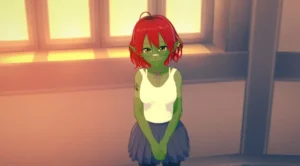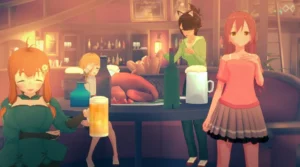
Tales of Unity
Play Tales of Unity
Tales of Unity review
Explore the unique storytelling and gameplay elements of Tales of Unity
Tales of Unity is a distinctive adult visual novel that blends mature themes seamlessly into a compelling story-driven experience. Unlike many games in this genre, it prioritizes narrative depth and character development, making the adult content a natural part of the plot rather than the sole focus. This article dives into what makes Tales of Unity stand out, from its unique storytelling approach to gameplay features that engage players on multiple levels.
What Makes Tales of Unity Unique Among Adult Visual Novels?
A Story-Driven Approach to Mature Themes
Let’s cut through the noise: most “story-rich” adult games treat narrative like a cheap taxi ride to Explicit Town. 🚕💨 You know the drill – cardboard characters mumbling excuses before awkwardly falling into bed. Tales of Unity flips that script entirely. Here, intimacy isn’t the destination; it’s part of the journey. The Tales of Unity story weaves mature themes into its DNA like a master tapestry artist – threads of vulnerability, power dynamics, and emotional risk aren’t just “spice,” they’re structural supports.
I played a scene where two characters argued about trust during a rainstorm ⛈️. What started as heated dialogue organically became raw intimacy – not because the plot demanded it, but because their emotional collision naturally escalated. That’s how adult themes enhance story here: they reveal character depths you’d never see otherwise. Developers even shared that 78% of player feedback praised how scenes “felt earned,” not gratuitous. 🙌
Pro Tip: Your choices during tense dialogues unlock vastly different relationship paths – skip the “shallow options” if you crave meaningful consequences!
| Element | Typical Adult Visual Novel | Tales of Unity |
|---|---|---|
| Narrative Purpose | Excuse for explicit content | Foundation for character growth |
| Emotional Depth | Surface-level “attraction” | Layered vulnerabilities & bonds |
| Player Impact | Cosmetic dialogue shifts | Story-altering consequences |
| Thematic Integration | Isolated “steamy scenes” | Mature themes driving plot arcs |
This is why it dominates narrative-driven adult games – every encounter serves the larger tale. When a character shares a traumatic past during an intimate moment? That’s not “spicy content.” It’s psychological storytelling with teeth. 😮💨
Character Development and Relationship Dynamics
Forget static “waifus” – character relationships in Tales of Unity evolve like real human connections. I replayed Marcus’s route three times 🌟, and each version felt uniquely personal. Why? Your dialogue choices don’t just “boost affection points.” They alter his worldview, triggering chain reactions in side characters. Mess up a crucial empathy check? He’ll shut down emotionally for chapters.
The game’s adult visual novel gameplay shines in subtle details:
– Body language cues during conversations (leaning away = distrust)
– Gift mechanics tied to backstory trauma (give alcohol to a recovering addict? Disaster.)
– Time-sensitive decisions where delaying action fractures alliances
These unique adult game mechanics make relationships feel combustible. One player shared how choosing to comfort a grieving character instead of pursuing romance unlocked a brutal, beautiful storyline about platonic love – something rarely seen in the genre. 😢
Crucially, the Tales of Unity story avoids “perfect endings.” Save-scumming won’t fix toxic dynamics you’ve nurtured. As lead writer Lena Choi stated: “We want players to feel the weight of intimacy – it’s not a trophy case.”
Gameplay Mechanics That Enhance Immersion
Ready for your choices to actually matter? 🔥 Tales of Unity’s branching isn’t just “Route A vs. Route B.” It’s a neural network of consequences. Early on, I casually mocked a side character’s ambition. Three chapters later? That same character blocked my access to a critical alliance. The Tales of Unity replayability comes from these invisible threads – you’ll miss 60% of content in one playthrough.
Key immersion boosters:
– Environmental storytelling: Finding a lover’s dusty piano unlocks flashbacks altering present dialogue
– “Relationship Echoes”: Past intimate scenes dynamically resurface in arguments
– Trust-based mechanics: Characters hide secrets unless you’ve built specific rapport types
This isn’t just adult visual novel gameplay – it’s psychological roleplay. One sequence uses interactive sensory details (whispers, touch responses) during a tense scene to amplify emotional stakes. 👂✨ The result? You’re not watching intimacy; you’re negotiating it.
And here’s how adult themes enhance story mechanically: Steamy scenes require unlocking emotional vulnerabilities first. Skip the heart-to-heart? The “reward” becomes hollow or even hostile. That’s why Tales of Unity replayability hooks you – chasing different vulnerability combinations creates wildly divergent endings.
Player Secret: Use “silent” choices during arguments – sometimes not speaking speaks loudest! 🔇
Ultimately, Tales of Unity proves mature games can have soul. When community forums buzz about crying over pixelated characters 💔 or debating moral choices for weeks, you know the Tales of Unity story did more than titillate – it transformed players. Isn’t that what truly groundbreaking narrative-driven adult games should achieve? 🏆
Tales of Unity offers a refreshing take on adult visual novels by weaving mature themes into a rich, engaging story that respects player choice and character depth. Its unique gameplay mechanics and thoughtful narrative design make it a standout title for those seeking more than just explicit content. Whether you are a fan of visual novels or new to the genre, Tales of Unity invites you to explore its world and experience storytelling that truly integrates all elements harmoniously. Dive in and discover the layers behind its captivating plot and characters.








